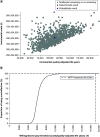Cost-effectiveness of lung cancer screening with volume computed tomography in Portugal
- PMID: 39329332
- PMCID: PMC11542083
- DOI: 10.57264/cer-2024-0102
Cost-effectiveness of lung cancer screening with volume computed tomography in Portugal
Abstract
Aim: Lung cancer is the most common cause of cancer death in Portugal. The Dutch-Belgian lung cancer screening (LCS) study (NELSON), the biggest European LCS study, showed a lung cancer mortality reduction in a high-risk population when being screened. In this study, the cost-effectiveness of LCS, based on the NELSON study protocol and outcomes, was evaluated compared with no screening in Portugal. Methods: The present study modified an established decision tree by incorporating a state-transition Markov model to evaluate the health-related advantages and economic implications of low-dose computed tomography (LDCT) LCS from the healthcare standpoint in Portugal. The analysis compared screening versus no screening for a high-risk population aged 50-75 with a smoking history. Various metrics, including clinical outcomes, costs, quality-adjusted life years (QALYs), life-years (LYs) and the incremental cost-effectiveness ratio (ICER), were calculated to measure the impact of LDCT LCS. Furthermore, scenario and sensitivity analyses were executed to assess the robustness of the obtained results. Results: Annual LCS with volume-based LDCT resulted in €558 million additional costs and 86,678 additional QALYs resulting in an ICER of €6440 per QALY for one screening group and a lifetime horizon. In total, 13,217 premature lung cancer deaths could be averted, leading to 1.41 additional QALYs gained per individual diagnosed with lung cancer. Results are robust based on the sensitivity analyses. Conclusion: This study showed that annual LDCT LCS for a high-risk population could be cost-effective in Portugal based on a willingness to pay a threshold of one-time the GDP (€19,290 per QALY gained).
Keywords: cost–effectiveness; lung cancer; screening; smokers and former smokers; volume-based low-dose CT.
Conflict of interest statement
Competing interests disclosure
The authors have no competing interests or relevant affiliations with any organization or entity with the subject matter or materials discussed in the manuscript. This includes employment, consultancies, honoraria, stock ownership or options, expert testimony, grants or patents received or pending, or royalties.
Figures


References
-
- Ferlay J, Ervik M, Lam F et al. Global Cancer Observatory: Cancer Today (2024). https://gco.iarc.who.int/today
-
- Borges M, Gouveia M, Alarcão J et al. Cost and burden of non-small-cell lung cancer's in Portugal. Value Health 17(7), A626 (2014). - PubMed
-
• Provides estimates of the substantial economic burden of non-small-cell lung cancer in Portugal.
-
- Duma N, Santana-Davila R, Molina JR. Non–small cell lung cancer: epidemiology, screening, diagnosis, and treatment. Mayo Clin. Proc. 94(8), 1623–1640 (2019). - PubMed
MeSH terms
LinkOut - more resources
Full Text Sources
Medical
